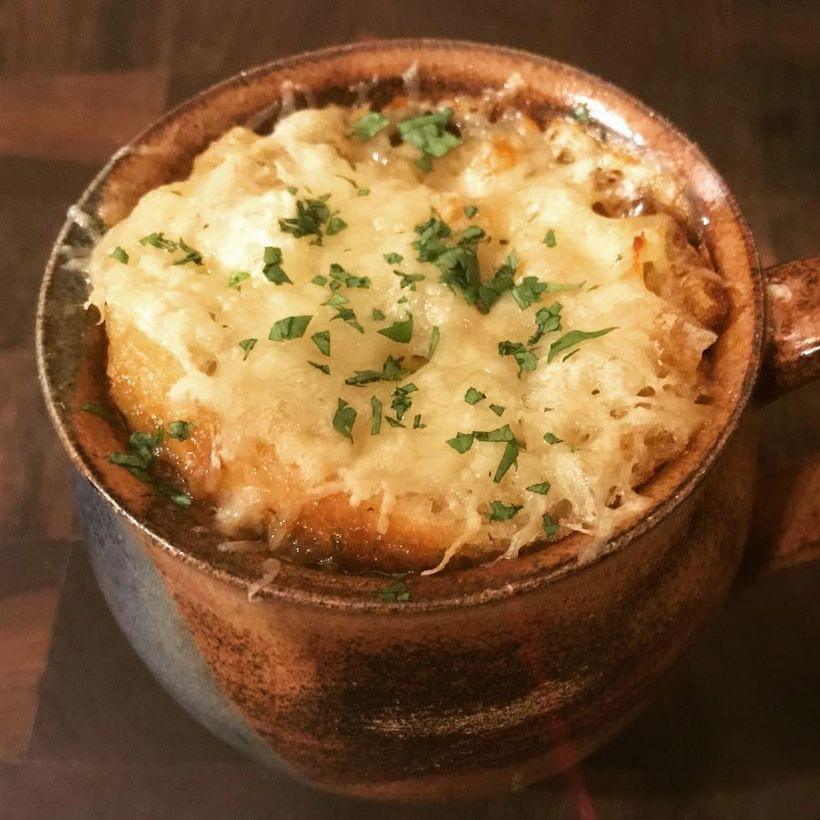French Onion Soup

This is the best French onion soup I’ve ever had. The secret ingredient, well, it isn’t onions.
Well, okay, yeah, there are still a lotta onions in this. More than a pound, in fact, for what turns out to be a pretty modest helping of soup. There’s nothing fancy going on in this department either: we had a red-plastic-mesh bag of run-of-the-mill supermarket yellow onions and a shortage of dinner plans, so here we are.
The secret is that we’ve also got a lot of shallots going in here, which is a direct result of not wanting to go out and buy additional onions—not some daring, cutting-edge approach to allium-based soups. It is, however, the ol’ “happy accident” foodblog cliché—and my new go-to recipe.
Caramelizing Onions (and Shallots)
This takes a long-ass time, despite what other food blogs might have you believe. Granted, a pinch of sugar speeds things along a little, as does a tiny pinch of baking soda. That said, countless batches of curry rice have made me pretty good at getting it done in relatively short order. Not "ten minutes, total" by any stretch, but maybe a spry half hour of stirring.
Twenty minutes at low-medium heat with a lid is gonna give you, well, not the prettiest arrangement of alliums you’ve ever seen in your life—something a little closer to a a stringy onion pudding. If you followed my advice on the baking soda, too, you might notice a little bit of a copper-green tinge to it. It ain’t exactly Instagram-worthy, but it isn’t gonna hurt anything, either; it’ll go away as they brown. Take off the lid carefully; there’s gonna be a lot of water on there.
Once you’ve reached this stage, lose the lid and dial the heat up to medium. You’re on the clock now, stirring every minute or two for the next twenty to thirty minutes.
Browning, here, is both the goal and the enemy. You want the whole slurry to inch toward “uniformly golden.” When in doubt, stick with lighter, not darker. Under-golden’d onions aren’t gonna be quite as rich and sweet as they could be, while dark brown onions are gonna be bitter and gross; you can probably guess which side you want to err on. I do this in an enameled cast iron, which I like for being a nice bright white on the inside: as soon as my slowly-browning onion sludge starts to form the slightest fond, I’ll move the onions to one side and add a splash of stock to deglaze, which also keeps it from happening again—at least, not right away. Keep it moving and you’ll be rewarded with surprisingly sweet for-realsies caramelized onions.
Clarifying Butter Quickly
Melt it in the microwave, without stirring; it’ll start to separate right away. Let it sit for a few more minutes, and you can then:
- Strain it through a coffee filter or a few layers of cheesecloth
- Carefully spoon or pour the butterfat off the top
Or, do what I do: after letting it settle and cool for a few minutes on the counter, chuck it in the fridge. The butterfat will solidify on top of the layer of dairy solids, so you can separate it without worrying about mixing it all back together by accident.
The Marmite Thing Again, Huh?
You look me in the eyes and tell me that the difference between the best French onion soup you’ve ever had, and “heated-up onion water” wasn’t a savory, meaty wholeness that you can’t quite describe in words. Well, that word is “glutathione”—Kokumi, if ya nasty.
Ingredients
-
4 Tbsp. Clarified unsalted butter, or a neutral oil
-
25 G. Garlic, three or four cloves, minced
-
2 tsp. Thyme, dried
-
1 tsp. Marmite
Optional -
500 G. Yellow onions, about five, thinly sliced
-
100 G. Shallots, thinly sliced
-
1 pinch Sugar
-
1/4 C. Sherry
-
1 qt. Stock, beef or vegetable
-
1 tsp. Cider vinegar
-
1 Tbsp. Soy sauce
-
1 Bay leaf
-
Thick cut, crusty slices of bread, buttered and toasted
-
1 C. Gruyère, grated
-
Salt and freshly ground pepper, to taste
Instructions
Add clarified butter to a heavy-bottomed pot (such as an enameled cast iron) over low-medium heat. Add garlic, dried thyme, and marmite (I usually add a few twists of black pepper at this point, as well).
Toss sliced onions with a pinch of sugar and baking soda, if using, then add to pot, stir, and cook over low-medium heat, covered, for twenty minutes.
Carefully remove lid and increase heat to medium, stirring constantly and deglazing with spoonfuls of stock as-needed until golden.
Add sherry and cook until the alcohol smell has mostly burned off; this should only take a few minutes. Add stock, cider vinegar, soy sauce, and a bay leaf. Simmer with lid slightly ajar for another half hour. Add salt and black pepper to taste.
Remove bay leaf and ladle into oven-safe cups/bowls; top with a crouton and handful of grated cheese. Place on a baking sheet and broil until the cheese is melted and slightly browned.